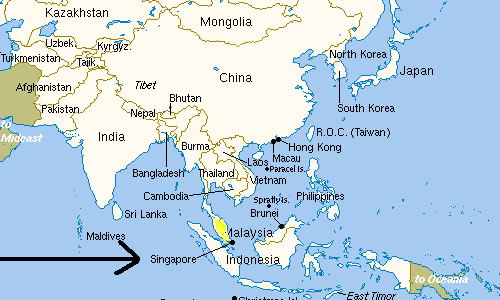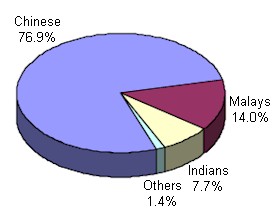
General Information

Statistics:
-
Name - Republic of Singapore
-
Area - 646 sq km
-
Population - 3.1 million (growth rate 1.3%)
-
Capital - Singapore
-
People - 78% Chinese, 14% Malay, 7% Indian
-
Language - Mandarin, Malay, Tamil and English
-
Religion - 31% Taoist, 28% Buddhist, 18% Muslim, 10% Christian, 4% Hindu
-
Government - Parliamentary democracy
-
President - Mr Ong Teng Cheong

Environment
The island Republic
of Singapore lies almost at the Equator in South East Asia.
Singapore lacks of
natural resources. There is a little agriculture, with the cultivation of
plants and vegetables, and some fishing; however, most foodstuffs and raw
materials have to be imported. Singapore's principal natural resource is
the superb natural harbor that with the exception of Rotterdam's, is the
busiest in the world.
The Republic of Singapore includes some 64 islets. It is a mainly flat country with low hills, the highest being Bukit Timah at 163m (545ft). In the northeast of the island large areas have been reclaimed, and much of the original jungle and swamp covering the low-lying areas has been cleared. [2]
History of the
country
According to Malay
legend, a Sumatran prince encountered a lion - considered a good omen - on
Temasek, prompting him to found Singapura, or Lion City. It mattered
little that lions had never inhabited Singapore (more likely the prince
had seen a tiger); what did matter was the establishment of the region as
a minor trading post for the powerful Sumatran Srivijaya empire and as a
subsequent vassal state of the Javanese Majapahit empire in the mid-13th
century. [3]
The British had first
established a presence in the Straits of Malacca (now called Melaka) in
the 18th century when the East India Company set out to secure and protect
its line of trade from China to the colonies in India. Fearing another
resurgence of Dutch expansionism - which had been the dominant European
trading power in the region for nearly 200 years – the British increased
their presence. which he was promptly given. Under British rule,
Singapore's reputation as a disease-ridden colony was soon forgotten.
Migrants, attracted by a tariff-free port, poured in by the thousands and
a flourishing colony with a military and naval base was established.
Singapore's growth
continued into the 20th century. However, the outbreak of WWII brutally
exposed the fallacy of British might: they suffered a great defeat when
Japan invaded the colony in 1941. The British were welcomed back after
Japan's surrender in 1945, but their right to rule was no longer assured.
By the 1950s, the
growth of nationalism had led to the formation of a number of political
parties as Singapore moved slowly towards self-government. The People's
Action Party, with the Cambridge-educated Lee Kuan Yew as leader, was
elected in 1959. Lee became prime minister, a position he was to hold for
the next 31 years. In 1963, Singapore formed a union with Malaya (now
Malaysia) but by 1965, the federation was in tatters. Singapore became
independent soon after and was once again the economic success story of
the region. Lee fashioned a government based on modernization and the
suppression of political opposition. Lee Kuan Yew resigned as Prime
Minister in 1990 and Goh Chok Tong - a leader more inclined towards
consultation and liberalism - took over. [4]
Economic profile
-
GDP: US$84 billion
-
GDP per head: US$21,500
-
Annual growth: 7%
-
Inflation: 2%
-
Major industries: Shipping, banking, tourism, electrical & electronics, oil refining
-
Major trading partners: US, Malaysia, Japan [5]
Culture of the
people
Despite rapid
industrialization, the majority of Singaporeans celebrate the major
festivals associated with their respective religions. The variety of
religions found in Singapore is a direct reflection of the diversity of
races living there. The four official languages of Singapore are Mandarin,
Malay, Tamil and English. [6]
English is widespread and is the language, which unites the various
ethnic groups. The use of Malay is mostly restricted to the Malay
community. The government is trying to promote Mandarin, the main
non-dialectal Chinese language, and has been very successful and
increasing numbers of Chinese now speak Mandarin at home. Tamil is the
main Indian language, though Malayalam and Hindi are also spoken.
The arts are presently in a state of rapid growth, with new groups and companies coming to the forefront and established ones attempting new art forms. Singapore aims to be a global city of the arts, hosting the best of the East and the West. Coupled with a range of cultural activities, Singaporeans are encouraged to lead healthy lives through recreational activities and sports. Comprehensive facilities are developed to support a wide variety of activities. The customs and festivals of the different ethnic groups in Singapore highlight the nation's rich cultural heritage. Singapore's people are largely descendants of immigrants from the Malay Peninsula, China, the Indian sub-continent and Sri Lanka.
References
-
http://www.lonelyplanet.com/destinations/south_east_asia/singapore/culture.htm
-
http://www.lonelyplanet.com/destinations/south_east_asia/singapore/culture.htm
-
Strategis